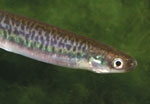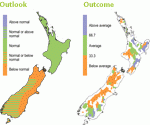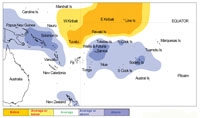PDF of this article (194 KB)




Restoration of inanga populations to enhance whitebait fisheries depends on improving both spawning and rearing habitat. But which is most important? Jody Richardson and Eddie Bowman report on some new research that may hold the key.
Regular readers of Water & Atmosphere will know of NIWA’s 'Sustainability and Enhancement of Whitebait Fisheries' research programme aimed at understanding and restoring populations of diadromous galaxiids. (Galaxiids are fish in the genus Galaxias, and diadromous means they migrate between the sea and freshwater.) The galaxiids in New Zealand include the five species whose juveniles are known as whitebait. We have focused much of our research on inanga because that is the main species caught by fishers during the annual whitebait migration. Along the way, we've found that some lowland streams seem to have lots of large inanga – but why?
Our studies in the Mokau River between 1998 and 2002 confirmed that, in general, inanga have a one-year life cycle: juvenile fish enter fresh water in spring, mature to adulthood over summer, and spawn in the autumn, with the next generation spending the winter at sea. We presumed that most inanga in the Mokau died after spawning because there were almost none in the stream each winter during the study, and at the end of the whitebait season, most fish in the stream were new recruits and less than a quarter were adults (more than 65 mm long). However, surveys in seven other streams gave more variable results: three of the streams had populations with at least a third adult fish, and in one stream half the fish in November were adults.
Big questions about big fish
We wondered why some streams had so many large fish. Were these fish less than a year old and exceptionally quick-growing? Or, had they failed to spawn the previous autumn and then overwintered in the stream? We also wondered if large inanga regularly occurred in certain streams, indicating habitat effects, or whether this was a random event that varied from year to year. For example, if these were fish that had failed to spawn the previous winter, was it because they did not have enough fat reserves to develop mature gonads (poor growth conditions) or was the spawning habitat so limited that there was not enough space for all the fish to spawn? Answering these questions could lead to a better understanding of conditions that favour good inanga growth, or to better management of inanga spawning grounds to enhance the fishery.
Comparing two rivers
Our recent study began last summer in two rivers: the Waikawau on the west coast of the North Island, just south of the Waikato, and the Nukuhou in the Bay of Plenty. Both rivers drain directly to the sea, although the Nukuhou, with a mean flow of 2.4 m3/s, is considerably larger than the Waikawau at 0.3 m3/s mean flow. We sampled in December 2004 and March 2005, using baited fine-mesh Gee minnow traps to catch the inanga. Traps were left overnight in low-velocity water on the edges of the rivers near cover such as overhanging or aquatic vegetation. We measured and weighed the inanga we captured and kept a sample of 60 fish from each river for gonad and age analysis.
The bar graphs show that in both rivers about a quarter of the December fish were adults. However, none of the December fish we sampled had mature gonads. By March, inanga populations in both rivers had decreased, but virtually all the fish remaining (80–90%) were more than 65 mm long. We found that the Nukuhou had more sexually mature inanga than the Waikawau (76% compared to 56%), and the female gonads were proportionally larger (when corrected for fish length) in the Nukuhou than in the Waikawau. It could be that the Waikawau fish are maturing later than those in the Nukuhou this year (perhaps due to water temperatures), or that the larger Nukuhou has more food and space, giving inanga more reserves for growth and gonad development.
Next steps in our study
Our preliminary results are raising some interesting questions and avenues for further investigation. Age analysis will reveal whether the larger fish have overwintered or not. Egg counts from the gonads will determine whether the larger fish contribute proportionally more offspring to the population. Further sampling this winter will reveal if large fish are present. The Waikawau has very limited spawning grounds, whereas spawning areas in the Nukuhou are abundant. If fish are forced to overwinter because they cannot spawn, then we would expect to see more large fish remaining in the Waikawau River. If limited amounts of suitable spawning sites are affecting inanga populations, then activities that restore and protect inanga spawning areas have much potential to enhance inanga populations.
Fishing for answers
- The usual life cycle of inanga lasts one year, but some streams have many adults present in spring.
- Are these oversized fish older or just faster growing?
- Could limited spawning habitat force some fish to overwinter?
Further reading and useful links
Richardson, J.; Taylor, M. (2002). A guide to restoring inanga habitat. NIWA Science and Technology Series No. 50. 29 p.
Richardson, J.; Jowett, I. (2005). Restoring streams for freshwater fish. NIWA Science and Technology Series No. 53. 55 p.
These guides are available as free PDFs from www.niwascience.co.nz/pubs/st/
Learn more about galaxiids in the NIWA Atlas of Zealand Freshwater Fishes.
Jody Richardson is based at NIWA Hamilton where she is a member of the freshwater fish team. Eddie Bowman assists the fish team whenever his NIWA Rotorua hydrologist job allows. This work was part of the FRST-funded programme 'Sustainability and Enhancement of Whitebait Fisheries'.
Author contact: [email protected]
Teachers’ resource for NCEA AS: Biology 90462 (2.6), 90717 (3.5). See other curriculum connections at www.niwa.co.nz/pubs/wa/resources
